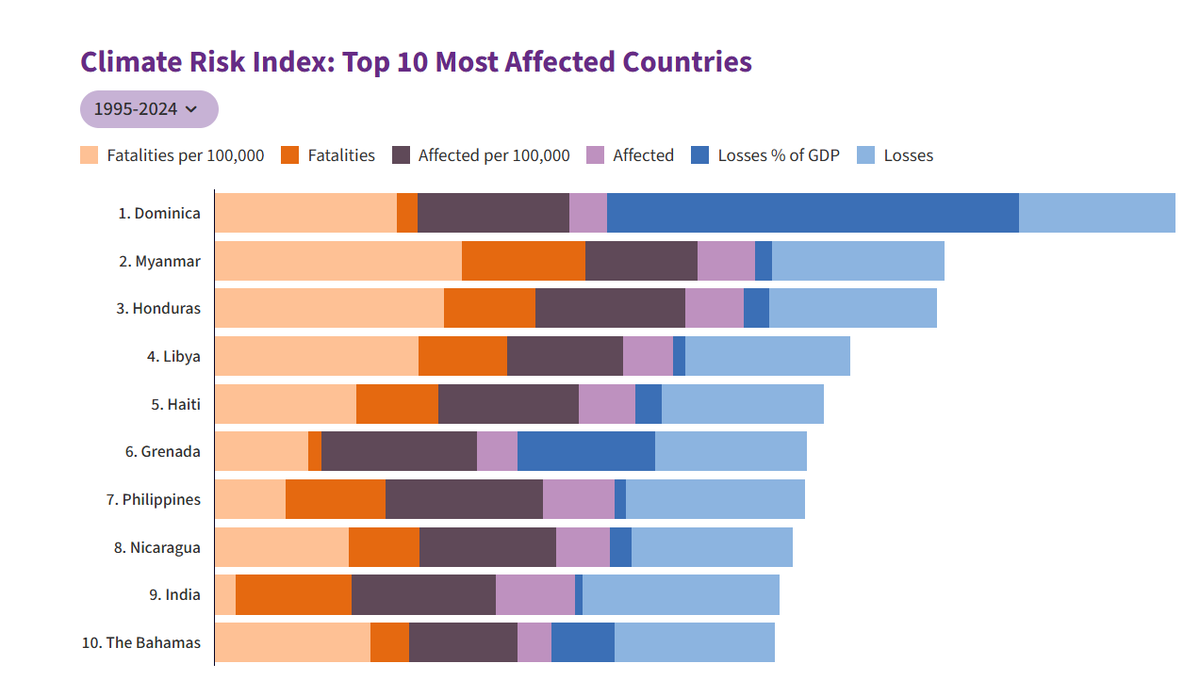The Germanwatch Climate Risk Index (CRI) 2026 report ranks India ninth among countries most affected by extreme weather events (1995–2024).
The Climate Risk Index 2026 published by Germanwatch at COP30 in Belém, Brazil, has sounded an alarm for India and the world. The report, analyzing three decades of climate data from 1995 to 2024, places India ninth among the most climate-affected countries. With over 832,000 deaths and economic losses exceeding USD 4.5 trillion recorded worldwide, the index serves as a wake-up call for policy action and climate financing.
Understanding the Climate Risk Index
The climate risk index is an annual publication by Germanwatch, an environmental think tank, that has been tracking the human and economic toll of extreme weather events since 2006. This tool measures the consequences of climate-related disasters, providing evidence of how global climate change has impacted nations over time.
The index evaluates countries based on six indicators covering absolute and relative measurements of economic losses, fatalities, and the total number of people affected by extreme weather events. Data is sourced from the EM-DAT International Disaster Database, the World Bank, and the International Monetary Fund, ensuring credibility and consistency in analysis.
Global Climate Change
The climate risk index 2026 documents over 9,700 extreme weather events between 1995 and 2024, making it one of the most comprehensive assessments of climate impacts. A comparative analysis with the Climate Risk Index 2025 reveals an acceleration of climate impacts.
Among the most affected countries in the long-term ranking, Dominica tops the list, followed by Myanmar and Honduras. Small Island Developing States (SIDS) bear the brunt of climate impacts despite contributing the least to global emissions. For 2024, St. Vincent and the Grenadines, Grenada, and Chad emerged as the most affected nations.
India's Position in Global Rankings
India’s ranking highlights its growing exposure and sensitivity to the escalating climate crisis. India is ranked 9th among most affected countries in the Climate Risk Index (CRI) long-term ranking (1995-2024), a slight improvement from 8th place in earlier assessment. In 2024, India ranks 15th among the countries most affected. In terms of the number of people most affected by extreme weather in 2024, India ranked third behind Bangladesh and the Philippines.
This persistent high ranking underscores the frequency and intensity of extreme weather events and the immense socio-economic toll they exact. Over the past three decades, India has experienced more than 430 extreme weather events, including floods, heatwaves, cyclones, and droughts, resulting in over 80,000 deaths, affecting 1.3 billion people, and causing economic losses exceeding USD 170 billion (inflation-adjusted).
According to the Germanwatch CRI, these losses translate into an annual average of USD 5.6 billion, disproportionately burdening low-income and agrarian communities that depend on climate-sensitive livelihoods.
The report describes India as facing “continuous climate threats”, where communities do not fully recover from one disaster before another strikes. The 2024 monsoon season exemplified this pattern, with unusually heavy rains and flash floods displacing more than 8 million people across Gujarat, Maharashtra, and Tripura.
Similarly, recurring floods in Assam and Bihar, severe heatwaves pushing temperatures above 48–50°C in Delhi, Rajasthan, and Uttar Pradesh, and back-to-back tropical cyclones such as Amphan (2020), Fani (2019), and Yaas (2021) demonstrate the widening geographic and temporal reach of climate extremes.

Science Behind Extreme Weather Events
Scientists have established a connection between anthropogenic climate change and the increasing frequency and intensity of extreme weather events. Over 600 studies have concluded that global climate change has increased the likelihood and severity of 74% of the extreme weather events assessed.
The report highlights that floods and storms accounted for 58% of total monetary damage, while heatwaves and storms caused two-thirds of all fatalities. Floods affected half of all victims, underscoring the need for flood management and early warning systems.
For India, these disasters have eroded development gains, pushing communities into a cycle of poverty and displacement. The scale of India's population and its dependency on the monsoon system make it vulnerable to climate variability.
Adaptation and Mitigation Crisis
The Climate Risk Index 2026 exposes a gap between climate planning and implementation. While 62 countries have submitted National Adaptation Plans (NAPs), their implementation remains lacking.
This deficit reveals that countries reeling from events lack the resources and bandwidth for long-term planning. Their budgets are overwhelmed by disaster recovery, preventing the work needed to prevent climate change impacts from worsening.
Developing countries face projected adaptation investment needs ranging between USD 130 billion and USD 415 billion per year by 2030. Yet the Adaptation Fund received only USD 130 million in 2024, less than half its annual target of USD 300 million.
Loss and Damage
The USD 4.5 trillion in losses documented in the climate risk index provides justification for operationalizing Loss and Damage mechanisms. Projections indicate that financial needs will grow to USD 1,132 to 1,741 billion per year by 2050.
COP30 witnessed the launch of the first call for proposals from the Fund for Responding to Loss and Damage (FRLD). The round will make USD 250 million available, with applications open from mid-December 2025 to June 2026.
However, experts warn that this level of funding is not enough. Developed countries have only promised $788 million, and less than $400 million has actually been transferred, meaning the fund has only a small fraction of the money it truly needs.
Path Forward
To prevent climate change impacts from spiraling out of control, the climate risk index 2026 presents policy imperatives:
- Mitigation Action: Global emissions must be reduced to keep warming below 1.5°C. Current mitigation efforts are insufficient, with the frequency of extreme weather events projected to increase as warming continues.
- Adaptation Finance: The New Collective Quantified Goal (NCQG) of USD 300 billion by 2035 must be restructured to include streams for loss and damage.
- NAP Implementation Support: International financial institutions must shift focus from planning to implementation of National Adaptation Plans for high-ranking countries in the climate risk index.
- Private Sector Engagement: The private sector has the potential to provide around USD 50 billion per year in adaptation finance through policy action and blended finance solutions.
Conclusion
The Climate Risk Index 2026 is more than a ranking. For India, ranking ninth with 80,000 deaths and USD 170 billion in losses, the message is clear: the time for incremental responses has passed.
As Germanwatch's David Eckstein states, "Global emissions have to be reduced, otherwise, there is a risk of rising deaths and economic disasters worldwide." The challenge now is to translate the data from the climate risk index into action: scaled finance, implementation of adaptation plans, and a commitment to climate justice.

Master Digital Age Governance & Technology Trends with VisionIAS Comprehensive Current Affairs →
Climate Risk Index 2026 FAQs
1. What is India's rank in the long-term Climate Risk Index 2026?
Ans. Ninth globally.
2. Which organization publishes the Climate Risk Index?
Ans. Germanwatch.
3. How many extreme weather events did India face from 1995-2024?
Ans. 430 events.
4. What are the total economic losses in India from climate disasters since 1995?
Ans. USD 170 billion.
5. Which country ranks first in the long-term Climate Risk Index 2026?
Ans. Dominica.